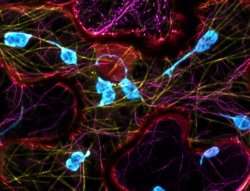New insight into plants' self-defense

Chloroplasts are the ultimate green machines—the parts of plant cells that turn sunlight into food in a fairly famous process known as photosynthesis.
But they have another role of critical value to plant life. They are part of the signal corps that alerts a plant's immune system to the threat of danger—whether by enemy attack or environmental stressor.
Now University of Delaware researchers and collaborators at the University of California-Davis have uncovered new details of how chloroplasts move about in times of trouble. It's the fundamental kind of research information that helps scientists understand plant biology and could help farmers prevent crop loss.
Their findings were published by eLife.
Using bioimaging techniques at the Delaware Biotechnology Institute, a team led by Jeffrey Caplan, director of the Bioimaging Center, has shown that chloroplasts morph into dramatically different shapes when danger approaches, sending out hollow shoot-like parts called "stromules" as part of the plant's immune response. These stromules then connect to the cell's nucleus and appear to guide the chloroplasts to their assigned posts.
Researchers don't know yet if the stromules act as escorts or provide the impetus for this transit—or both. But the images show direct correlation.
"This could point to new methods for crop protection against various pathogens," Caplan said. "This is a basic response, not specific to any one pathogen."
For this study, researchers used cells from a relative of the tobacco plant—nicotiana benthamiana—which has many properties of value for study and imaging.
They used fluorescent proteins to mark structures in the cells—the stromules and the cytoskeleton—and those markers made it possible to monitor the structures with laser-scanning confocal microscopy. A confocal microscope, part of the expansive toolbox in DBI's Bioimaging Center, allows scientists to capture three-dimensional images of molecules.
In the same way, they can see the relationship between stromules, microtubules and the actin filaments that act as anchoring points as the stromules move along.
There is much to see, even in this tiniest of tiny contexts, where stromules vary in size from 1 micron to 10s of microns, up to 100 microns.
Guided—or perhaps propelled—by the stromules, the chloroplasts then cluster around the cell's nucleus as the battle against a pathogen develops. Researchers have found that increasing stromule formation also speeds a plant's immune response.
Future research can build on this new understanding of stromules to see if changing some of the dynamics can help a plant resist damage from disease and other stressors.
Eleven other researchers contributed to the article, and Caplan said beyond this team are many other UD researchers whose expertise often is helpful in such studies.
"UD has a wonderful work environment," Caplan said. "We work together to study many different aspects of disease resistance."
More information: Amutha Sampath Kumar et al. Stromule extension along microtubules coordinated with actin-mediated anchoring guides perinuclear chloroplast movement during innate immunity, eLife (2018). DOI: 10.7554/eLife.23625
Journal information: eLife
Provided by University of Delaware




















